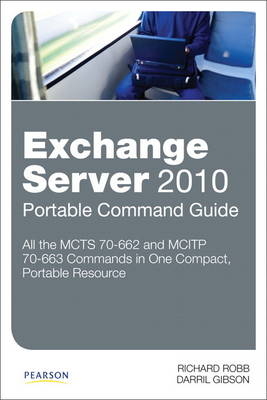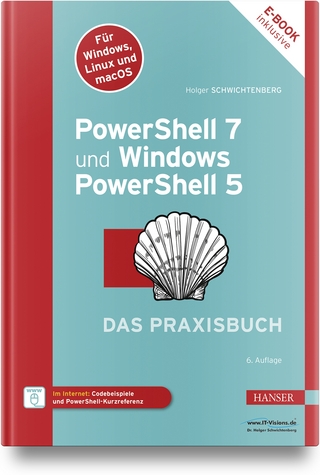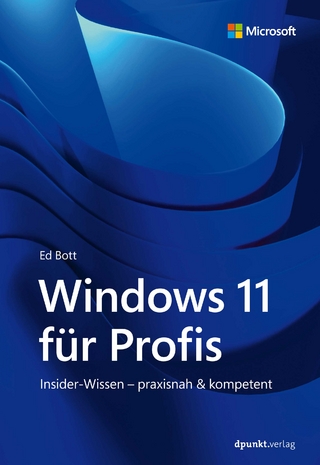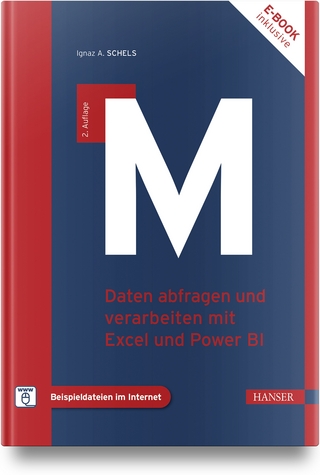
Exchange Server 2010 Portable Command Guide
Pearson IT Certification (Verlag)
978-0-7897-4736-5 (ISBN)
- Titel ist leider vergriffen;
keine Neuauflage - Artikel merken
MCTS 70-662 and MCITP 70-663
Richard Robb
Darril Gibson
All the MCTS 70-662 and MCITP 70-663 Commands in One Compact, Portable Resource
Maximize your efficiency as an Exchange Server 2010 administrator, and master the commands, keywords, command arguments, options, and prompts covered on Microsoft’s MCTS 70-662 and MCITP 70-663 exams! This easy, handy reference brings together all the techniques, tips, tools, and examples you’ll need. It’s your perfect take-anywhere guide to running Exchange Server 2010 environments—and passing Microsoft’s two key Exchange Server 2010 administration exams.
Covers all the commands you need to score higher on your MCTS 70-662 and MCITP 70-663 exams!
Master Exchange Server 2010’s newest administration features
Plan and implement deployments and upgrades
Use bulk management tools to administer multiple recipients or mailboxes
Configure hub and edge transport, rules, and agents
Work with mailboxes, mailbox servers, databases, and public folders
Set up Client Access Server, Outlook access, and certificates
Maximize availability with Database Availability Groups (DAGs)
Recover from multiple forms of server failure
Use default message routing and Exchange hub sites
Implement and operate Unified Messaging (UM)
Integrate Exchange Server 2010 into older Exchange environments
Use scripts to automate administration
Configure Role-Based Access Control (RBAC) permissions
Leverage Exchange Management Shell’s reporting capabilities
Troubleshoot Exchange Server with Test cmdlets
Your Perfect Take-Anywhere Exchange Server 2010 Command Resource!
Covers PowerShell commands on the MCTS 70-662 and MCITP 70-663 exams
Includes important administration commands that aren’t on the exams
Packed with realistic scenarios, high-efficiency examples, and expert tips
Includes many of the new SP1 cmdlets!
Category: Microsoft Certification
Covers: Exchange Server 2010 Exams (MCTS 70-662 and MCITP 70-663)
Richard Robb has been a respected technical trainer and messaging field consultant on Microsoft Exchange Server for the past 13 years after changing careers. In his “second career,” Mr. Robb has earned quite a number of technical certifications, including Microsoft Certified Trainer (MCT), Microsoft Certified IT Professional (MCITP) for Exchange Server 2010, as well as Exchange Server 2007. He is also certified on Exchange Server 2003. He has worked with every version of Exchange Server back to Exchange 5.5 and also has experience with other messaging systems, such as Lotus Notes. In addition to his Exchange certifications, Mr. Robb has earned other certifications, such as Microsoft Certified IT Professional (MCITP) for Windows Server 2008, Microsoft Certified Systems Engineer (MCSE) on Windows Server 2003, 2000, and NT 4.0, Microsoft Certified Systems Administrator (MCSA) on Windows Server 2003 and 2000, as well as Microsoft Certified Desktop Support Technician (MCDST). He also holds Certified Novell Engineer (CNE) and A+ certifications and has delivered classes for many top Fortune 500 companies as well as many governmental agencies in the United States and Canada. Mr. Robb currently works as an independent contractor providing Exchange Server training and consulting throughout the United States and Canada. He has also been part owner of a computer consulting company and part owner of a Microsoft and IBM Lotus training company with a six-room training center in southeastern Pennsylvania. A former restaurant general manager of a 400-seat full-service seafood restaurant, Mr. Robb was at the forefront of the move from simple point-of-sale cash registers to network operation systems in the food service industry and spearheaded the move to using computers in the restaurant for everything from cash registers to databases for managing inventory. Richard Robb, an accomplished computer hobbyist in the early 1980s, united his keen interest of computers with a methodical research into the exploding IT industry and made the move from food service to information technology full time. He worked as a field consultant for some time after leaving the restaurant industry, but when the opportunity arose to instruct, it coupled two things that he loves to do: work with computers and teach. Mr. Robb is a graduate of Gettysburg College in Gettysburg, Pennsylvania, with a dual major in Psychology and Economics. He also holds a Bachelor of Arts degree. Mr. Robb also authored the book MCITP Guide to Microsoft Windows Server 2008, Enterprise Administration, a lab guide for hands-on exploration of Windows Server 2008, with a focus on studying for and passing Microsoft Certification Exam 70-647. Darril Gibson is the CEO of Security Consulting and Training, LLC. He regularly teaches, writes, and consults on a wide variety of security and technical topics. He has been a Microsoft Certified Trainer for more than 10 years and holds several certifications, including MCSE (NT 4.0, 2000, 2003), MCDBA (SQL Server), MCITP (Windows 7, Server 2008, SQL Server), ITIL v3, Security+, and CISSP. He has authored, coauthored, or contributed to more than a dozen books. You can view a listing of most of his current books on Amazon (http://amzn.to/bL0Obo).
Introduction xvi
Part I: An Overview of Windows PowerShell 2.0 for Exchange 2010
Chapter 1 New Features and the Exchange Management Shell 1
What’s New in PowerShell 2.0 1
What Is a Cmdlet? 4
The Exchange Management Shell 6
Chapter 2 Basic Techniques 11
Using the GUI 11
Understanding the Basic Syntax of a cmdlet 12
Basic Syntax: Some Common Cmdlets Using the Get Verb 16
Basic Syntax: Some Common Parameters 27
Finding the Right Cmdlet 31
Finding Help for the Right Cmdlet 32
What’s Included in Each Version of Help 33
Using the Tab Completion Feature 34
Part II: Achieving a Comfort Level with PowerShell
Chapter 3 Advanced Techniques 37
Working with Pipelines 37
Running Programs 41
Creating and Running Scripts 42
Registry Modifications with PowerShell 48
Understanding Quotes 48
Chapter 4 Customizing the PowerShell Environment 51
Creating and Using PowerShell Profiles 51
Using Built-in Aliases 56
Working with User-Defined Aliases 57
Filtering Output 59
Formatting Output 60
Part III: PowerShell and the Exchange 2010 Deployment Process
Chapter 5 Standard Deployments 65
Deploying Prerequisites for All Versions of Exchange Server 2010 on Windows Server 2008 Operating Systems 65
Deploying Prerequisites for Exchange Server 2010 RTM (Release-to-Manufacturing) on Windows Server 2008 SP2 66
Deploying Prerequisites for Exchange Server 2010 RTM on Windows Server 2008 SP2 67
Deploying Prerequisites for Exchange Server 2010 RTM on Windows Server 2008 R2 69
Deploying Prerequisites for Exchange Server 2010 SP1 on Windows Server 2008 R2 72
Setup Options for Exchange Server 2010 RTM 74
Upgrading from Exchange Server 2010 RTM to SP1 78
Using the Exchange 2010 Deployment Assistant 80
Chapter 6 Disaster Recovery Deployments 83
Recovering from a Single Role Failure 83
Recovering from a Multiple-Role Failure on the Same Server 85
Recovering from a Database Availability Group (DAG) Member Server Failure 89
Part IV: PowerShell and Recipient Objects
Chapter 7 Working with Recipient Objects 93
Identifying the Exchange 2010 Recipient Types 93
Creating and Managing a User Mailbox 101
Creating and Managing a Mail-Enabled User 104
Creating and Managing a Mail-Enabled Contact 106
Creating and Managing Resource Mailboxes 108
Working with Distribution Groups 109
Converting Recipient Types 112
Creating and Managing Email Address Policies 113
Creating and Managing Address Lists 116
Chapter 8 Bulk Management of Recipients 121
Creating Multiple Recipients 121
Modifying Multiple Recipients 129
Reconnecting Multiple Disconnected Mailboxes 133
Part V: PowerShell and the Transport Roles Message Routing
Chapter 9 The Hub Transport Role 135
Configuring Accepted and Remote Domains 135
Get-AcceptedDomain 136
New-AcceptedDomain 136
Set-AcceptedDomain 137
Remove-AcceptedDomain 137
Get-RemoteDomain 138
New-RemoteDomain 138
Set-RemoteDomain 138
Managing Email Address Policies 141
Working with SMTP Connectors and Other Transport Objects 144
Send Connectors 144
Receive Connectors 148
Other Transport Cmdlets 151
Working with Routing Group Connectors 152
Managing Transport Queues 154
Chapter 10 The Edge Transport Role 157
Creating an Edge Subscription 157
Edge Synchronization 159
Cloning an Edge Transport 161
Address Rewriting 165
Chapter 11 Configuring Rules and Agents on Transport Servers 169
Transport Rules and Transport Agents 169
Transport Rules 169
Transport Agents 173
Journaling Rules and Journaling Agents 174
Journaling Rules 174
Journaling Agents 176
Anti-Spam Agents 177
Part VI: PowerShell and the Client Access Server Role
Chapter 12 CAS Services 179
Configuring Outlook Access 179
Enabling and Configuring Outlook Anywhere Access 180
Enabling and Configuring OWA Access 181
Configuring POP3 and IMAP4 182
Configuring the Autodiscover Service 183
Configuring the Offline Address Book (OAB) 184
Chapter 13 Working with Certificates 187
Types of Certificates 187
Generating a Certificate Request 187
Importing the Certificate 191
Enabling the Certificate 192
Part VII: PowerShell and the Mailbox Role
Chapter 14 Mailbox Servers and Databases 193
Configuring the Properties of a Mailbox Server 193
Creating and Mounting a New Database 194
Managing an Existing Database 196
Removing an Existing Database 201
Chapter 15 Working with Mailboxes 203
Exporting a Mailbox 203
Importing a Mailbox 207
Moving an Online Mailbox 208
Running the Clean-MailboxDatabase Cmdlet 211
Chapter 16 Using the Recovery Database (RDB) 213
Creating the Recovery Database (RDB) 213
Restoring a Database to the RDB 216
Removing the RDB 218
Part VIII: PowerShell and the Unified Messaging Role
Chapter 17 Working with Unified Messaging (UM) Role Objects 219
Configuring the Properties of a UM Server 219
Creating and Managing Dial Plans 220
Creating and Managing UM IP Gateways 223
Creating and Managing Hunt Groups 224
Creating and Managing UM Mailbox Policies 225
Monitoring and Troubleshooting a UM Server 226
Chapter 18 Managing Unified Messaging (UM) Users 229
Managing the UM Auto Attendant 229
Working with Call Answering Rules 234
Exporting UM Call Data Records 234
Working with UM-Enabled Mailboxes 235
Part IX: PowerShell and Message Routing
Chapter 19 Exchange Server 2010 Message Routing 239
Using Default Message Routing 239
Using Exchange Hub Sites 241
Using Exchange-Specific Costs on Site Links 242
Tracking Messages with PowerShell 246
Chapter 20 Integrating Exchange Server 2010 into an Existing Exchange Server 2003 Environment 249
Configuring Routing with Exchange Server 2003 249
Suppressing Link State Updates On Exchange 2003 Bridgehead Servers 253
Part X: PowerShell and High Availability in Exchange 2010
Chapter 21 Database Availability Groups (DAGs) 255
Creating and Configuring a DAG 255
Adding or Removing a DAG Member 260
Recovering a Failed DAG Member 263
Creating and Configuring a DAG Network 265
Removing a DAG 268
Chapter 22 Mailbox Database Copies 269
Adding and Configuring a Mailbox Database Copy 269
Moving the Active Mailbox Database Copy to a New Location 272
Suspending or Resuming a Mailbox Database Copy 274
Updating a Mailbox Database Copy 276
Removing a Copy of a Mailbox Database 276
Chapter 23 Using DAG to Mitigate Failures 277
Activating a Mailbox Database Copy on Another DAG Member 277
Activating a Lagged Mailbox Database Copy on Another DAG Member 279
Switching Over to Another DAG Member 282
Switching Over to Another Datacenter 283
Enabling Datacenter Activation Coordination (DAC) Mode 285
Chapter 24 Monitoring Highly Available Databases 289
Monitoring Using the Exchange Management Console 289
Monitoring Using PowerShell Cmdlets 290
Monitoring Using Event Viewer 291
Monitoring Using PowerShell Scripts 293
Part XI: PowerShell and Public Folders
Chapter 25 Public Folder Database Management 297
Installing Public Folders 297
Creating a Public Folder Database 298
Configuring a Public Folder Database 299
Removing a Public Folder Database 301
Chapter 26 Managing Public Folders 303
Assigning a Default Public Folder Database to a Mailbox Database 303
Creating and Managing Public Folders 305
Replicating Public Folders 307
Removing a Public Folder 308
Chapter 27 Public Folder Permissions 309
Adding Administrative Permissions to the Folder Structure 309
Controlling Top-level Public Folders 312
Setting Client Permissions to Public Folder Content 312
Part XII: Troubleshoot Exchange Server 2010 Using PowerShell
Chapter 28 Troubleshooting with the Test Cmdlets 315
Using Test Cmdlets for All Roles 315
Using Test Cmdlets for the Mailbox Role 317
Using Test Cmdlets for the Transport Roles 318
Using Test Cmdlets for the Client Access Server Role 320
Using Test Cmdlets for the Unified Messaging Role 321
Using Test Cmdlets for Client Connectivity 321
Using Helpful Non-Exchange Test Cmdlets 323
Chapter 29 Event Logging with PowerShell 325
Retrieving Events with Get-EventLog 325
Setting Diagnostic Event Log Levels 328
Part XIII: PowerShell and Automating Exchange Server 2010 Administration
Chapter 30 Using and Finding Scripts to Automate 331
Using Scripts to Automate Tasks in PowerShell 331
Finding Scripts to Automate Tasks in PowerShell 335
Part XIV: Monitoring Role-Based Access Control (RBAC) Permissions, Mailbox Audit Logging, and Reporting with PowerShell in Exchange Server 2010
Chapter 31 Configuring Role-Based Access Control (RBAC) Permissions 339
Creating and Managing a Management Role Group 339
Adding Members to the Management Role Group 341
Retrieving Information about Role Groups and Role Group Members 343
Setting and Viewing Management Scopes 345
Chapter 32 Using Mailbox Audit Logging to Monitor Exchange Server 347
Enabling Mailbox Audit Logging 347
Initiating Administrative Actions to Test Mailbox Audit Logging 349
Initiating a Search of the Mailbox Audit Log 352
Chapter 33 Reporting and Other Useful Cmdlets 355
Obtaining Information about a Mailbox with Get-MailboxStatistics 355
Retrieving Logon Information about Currently Active Sessions with Get-LogonStatistics 359
Using Other Useful Cmdlets 361
Appendix A Lab Environment Used for This Book 367
The Platform on Which the Virtual Machines Ran During the Writing of This Book 367
The Lab Environment Used in this Book 368
Creating Test Users and Mailboxes for the Lab Environment 369
Conclusion 372
Appendix B Create Your Own Journal Here 373
9780789747365 TOC 5/11/2011
| Erscheint lt. Verlag | 16.6.2011 |
|---|---|
| Verlagsort | Upper Saddle River |
| Sprache | englisch |
| Maße | 155 x 227 mm |
| Gewicht | 526 g |
| Themenwelt | Informatik ► Betriebssysteme / Server ► Windows |
| Informatik ► Betriebssysteme / Server ► Windows Server | |
| Informatik ► Weitere Themen ► Hardware | |
| Informatik ► Weitere Themen ► Zertifizierung | |
| ISBN-10 | 0-7897-4736-7 / 0789747367 |
| ISBN-13 | 978-0-7897-4736-5 / 9780789747365 |
| Zustand | Neuware |
| Haben Sie eine Frage zum Produkt? |
aus dem Bereich


